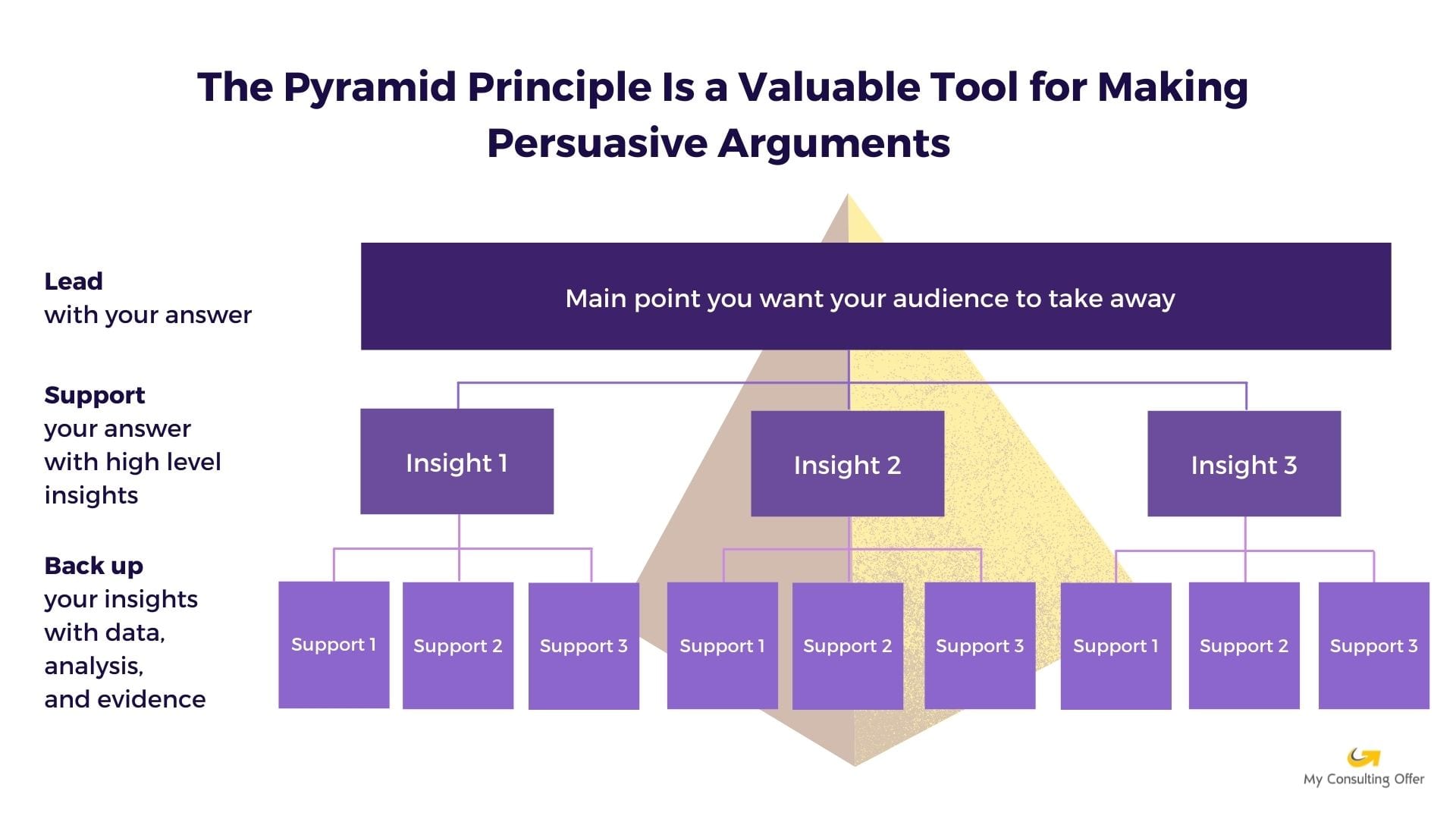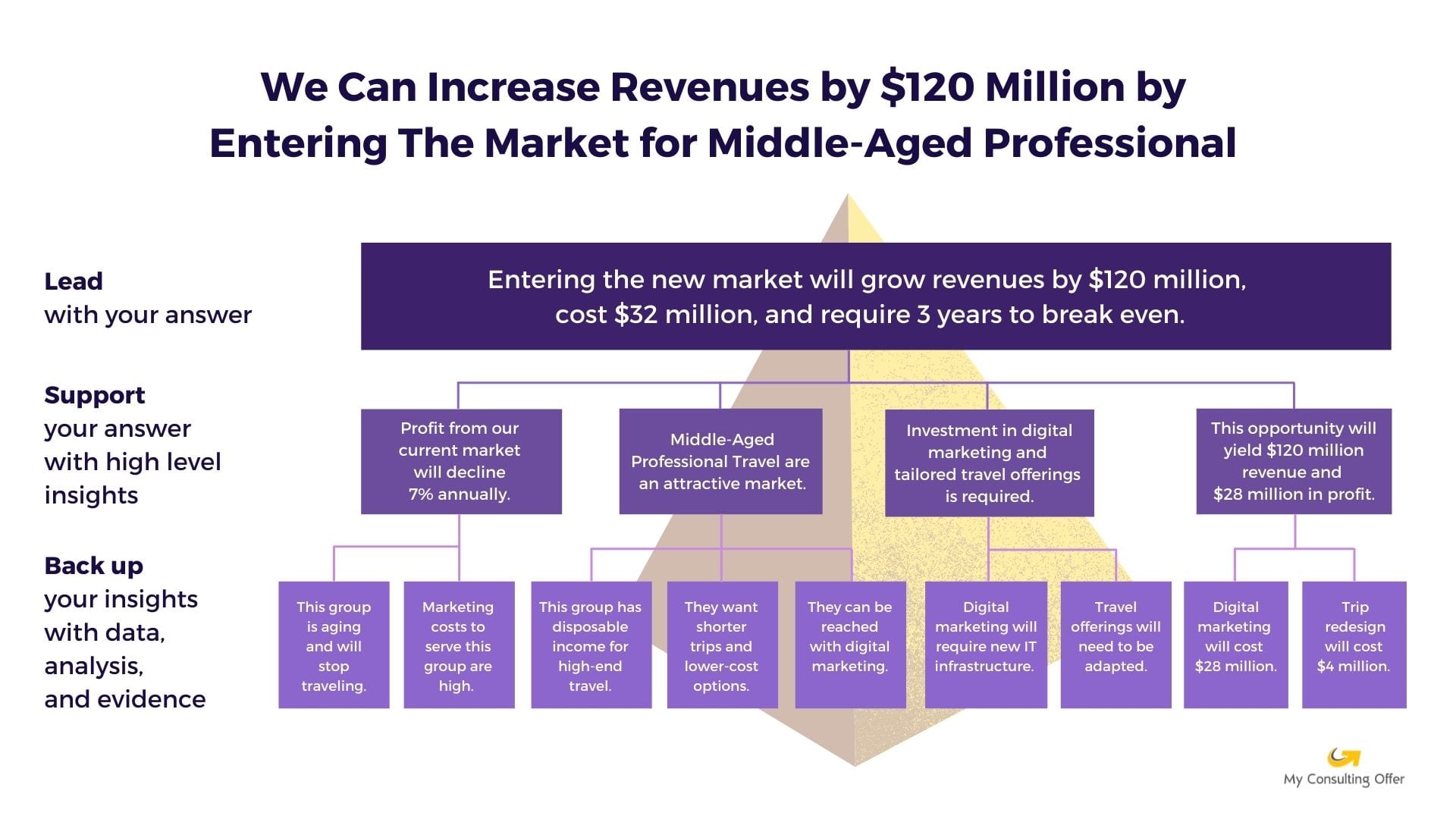


Liz Kenney
Former McKinsey Consultant
The Pyramid Principle is an effective communication tool to quickly and clearly communicate complex issues to busy business executives.
It was developed by Barbara Minto, a McKinsey consultant, and is used not only by McKinsey but by most major consulting firms.
Minto’s Pyramid Principle is one of several tools you’ll need to master to ace your consulting case interviews.
In this article, we’ll discuss:
- What is the Pyramid Principle?
- Why is it an effective communication tool?
- How can the Pyramid Principle help you with consulting case interviews?
- The Pyramid Principle in action: a case example.
Let’s get started!
What is the Pyramid Principle?
The Pyramid Principle is a valuable communication tool that you can use for case interviews or any time you want to make a persuasive argument. Its core elements are to:
- Lead with the answer first. The most important part of the Pyramid Principle is to make your recommendation(s) right away,
- Support the answer with key facts and insights at a high level. Synthesize the main takeaways from your analysis–your supporting arguments or even challenges to your recommendations, and
- Back up key insights with detailed data, analysis, and evidence. These back-up pages will probably include many of the analyses you perform first and summaries of the evidence you gather. These data points help you and your listener understand the situation clearly and see how it all adds up to your recommendations.
The Pyramid Principle actually reverses the typical flow of information when compared to the way most people naturally answer questions, but it’s a valuable communication tool for consulting.
Pyramid Principle Example
Take a basic question like, “Honey-bear, what time will you be home for dinner?”
Most people answer the question like this: “Well, Poopsie, I have to drop off my dry cleaning, return a video to Blockbuster, and pick up Fozzie from the groomer, so I should be home at 6 p.m.”
If you answer this way, your partner probably spaces out during the list of errands and snaps to attention when they hear “6 p.m.” What they need to know is that they can expect to eat dinner with you after 6 p.m.
Using the Pyramid Principle, you’d answer the question like this: “I should be home at 6 p.m. because I have to drop off my dry cleaning, return the video to Blockbuster, and pick up Fozzie from the groomer.”
Because you start with the most essential information (you’ll be home at 6 p.m.), your partner can follow along more easily because you answered their question first!
Alternative Pyramid Structures
You can choose the way you organize information using The Pyramid Principle, just be mindful about how you do so. In the example above, you can organize the information in one of three ways:
- Sequential: In this instance, you should list picking up Fozzie last, so he doesn’t have to wait in the car while you run other errands.
- Importance: In this instance, you would list picking up Fozzie first, since that’s the most important of the errands (you don’t want to leave him overnight at the groomers!)
- Impact: If you’re trying to return a video to Blockbuster, you probably owe a HUGE fine (RIP Blockbuster). So the cost of returning the video to Blockbuster would be the largest, and you’d start with that.
There are many reasons why you would choose a particular pyramid structure. Choose one and be prepared to defend why you did so.
Now let’s talk about why we use the Pyramid Principle in consulting.
Why Is the Pyramid Principle an Effective Communication Tool?
The Pyramid Principle helps you organize discussions with busy executives and makes your business writing more effective.
Strategy consultants exist to tackle the most challenging business problems. If clients’ issues were easy to solve, they’d solve them quickly with their own teams. So management consulting teams cram a lot of analysis, research, and synthesis into every project.
But clients don’t have a ton of time to absorb all the great information and insights gathered to solve their problem. They have full-time jobs that keep them really busy.
The Pyramid Principle helps C-suite executives absorb your message quickly because it uses vertical relationships between the key points:
- Top level: The summary point you need to communicate.
- Second level: The key supporting arguments: top-level points.
- Third level: grouped ideas that support second-level points: the data that leads to your answer.

You begin with the answer first by communicating your summary point. This way, the listener has time to absorb that point and can easily see how your later supporting ideas strengthen your argument.
The third-level data supports the second-level points, resolving any questions that someone might raise and further strengthening your argument. Each piece of information in your pyramid supports the level above it.
Communicating Efficiently Is Especially Important with Busy Executives
The efficiency of the Pyramid Principle is especially important when you’re talking to client executives or anyone in the C-Suite. They have likely invested millions of dollars in the consulting project and want to know immediately if it was worth it.
What’s ‘worth it’ for executives? They want to know that your recommendation will move the needle in a big way for revenue, costs, or any other key metric that is essential to the project.
For example, I had one client, a senior executive, who wanted to start every weekly meeting with a list of the cost-saving recommendations the team had identified and their projected impact for the rest of the year.
He wasn’t interested in any of the details until we’d communicated, “So far we’ve identified $X million in savings across these Y initiatives.” Then we could walk him through the biggest and best ideas of the week and the data to support our recommendations.
Use of the pyramid principle also highlights your structured thinking. It shows the executive you’re presenting to that your recommendations are well supported, not half-baked.
So don’t bury the lead by putting your recommendations and their impact all the way at the bottom of a long, dense page or at the back of the deck.
When executed well, this framework first, shares your answer, second, presents supporting ideas, and third, provides key details.
For any of our scientific readers out there, another way to think about the Pyramid Principle is the difference between inductive vs. deductive reasoning.
Inductive reasoning means that you walk through data and build a case piece by piece until you get to the recommendation at the end.
Deductive reasoning means you assert an answer up top and back it up with data.
Most of us tend to think using inductive reasoning in our daily lives. And that’s okay! But as a consultant, you will want to embrace the ‘answer first’ mindset in order to keep clients (and partners at your firm) engaged.
You will definitely get a consulting partner’s attention if you mention, “I think I’ve found a multi-million dollar opportunity.”
It seems funny to casually mention that you’ve identified multi-million dollar opportunities, but that is quite typical when working with clients in the Fortune 500.
Let’s take a look at how this knowledge will help you with consulting interviews.
How Can the Pyramid Principle Help You with Consulting Case Interviews?
There are 3 key opportunities in a case to use the Pyramid:
- At the beginning of the case, to synthesize your thoughts on the structure you lay out
- In the middle of the case, when you’re brainstorming solutions. You can use buckets to lay out the broad categories the solutions will fall into and brainstorm specific ideas within those buckets
- At the end of the case, to synthesize and communicate your recommendations
Check out the case study below, where we’ll show you an example of how to use the Pyramid Principle to synthesize your thoughts on the upfront structure.
For now, let’s go over how you can use it to share your recommendations at the end of the case.
Using the Pyramid Principle to Synthesize Your Recommendations
In a typical case interview, you’ll have spent 20-25 minutes structuring a problem, gathering data, doing analysis, and brainstorming solutions. Then, you need to sum all this work up with a nice neat bow.
How can you do that?
We recommend the 5R structure. The 1st 3 of these R’s tie nicely into the Pyramid Principle framework:
- Recap the client’s problem.
- Recommend a solution for the client.
- Reasons supporting your recommendation.
The recap reminds you and your interviewer of the problem you were trying to solve. Recommend is the 1-2 sentence summary of your solution for the client. This is your “answer first.” Reasons are the 3 detailed supporting arguments that support your recommendation.
The last 2 R’s in the 5R method are Risk and Retention. In risk, you should mention any risks the client might encounter in implementing your recommendation and provide suggestions for minimizing those risks. Retention refers to looking at how the team can add value to the client’s project in its next stage, thereby retaining their business. These 2 R’s go beyond the strict definition of the case question, but distinguish good case performance from distinctive performance.
This 5R structure is also frequently used in PowerPoint Communications by consultants.
The Pyramid Principle in Action: A Case Example
Here’s a case example to demonstrate how to use the Pyramid to structure your case and to provide recommendations:
Your client is a travel company that serves a mature clientele. They are looking to expand their business by targeting new customer segments while keeping their current customers delighted. The client’s current marketing spend is almost entirely centered on direct mail and catalogues, and their services are at a very high price point for 7+ day trips.
The question we’re trying to answer is:
How should your client think about shifting their service mix and marketing spend to serve the new customer segments and increase revenues by $100 million?
Using the Pyramid Principle to Structure Your Analysis
Start with your upfront thesis:
By entering the new customer segment, we can increase revenues by $100 million. To do so, we need to understand the following 4 things:
- What is our current market, and how do we reach it?
- Who are the client’s key customer segments today?
- What’s important to them?
- What’s included in the client’s direct mail materials?
- How often does the client send mail to our segments, and how much does this cost annually?
- How do those costs compare to peers or other industries?
- What services and features do our customers love today?
- What are their top complaints?
- What are the new priority market segments, and how do we reach them?
- What are the priority customer segments for the future?
- What’s important to them?
- How do these customers perceive direct mail?
- Do these new segments prefer other marketing channels (e.g., email, social media)? Can we save money by using other channels?
- What can we expect to learn about customers by using digital marketing tactics?
- What services and features will these customers prefer during their travels?
- What do they dislike about travel?
- What gaps in the client’s capabilities need to be overcome to meet the needs of new customer segments?
- What is consistent among our current and future priority customer segments? What’s different between these customer segments?
- What gaps in services does the client have to meet new customer segments’ needs?
- How much spending can be directed away from services for mature segments and toward services for both mature and younger segments? Or do we need incremental marketing spend to reach younger segments?
- What marketing channels do younger segments prefer? Which channels might be helpful to reach both mature and younger segments?
- What digital marketing systems, tools, people, and processes does the client have in place?
- How much spend can be directed away from direct mail towards digital marketing activities and newer segments?
- Finally, we need to estimate the size of the opportunity in terms of revenue and profit. Therefore, we’d like to understand:
- How much revenue and profit is driven by today’s mature segments?
- How is this changing?
- What is the typical price point for our current customers?
- How much incremental revenue can be provided by the priority segments to help us meet our target of $100 million?
- What is the cost of each of these initiatives?
This list of questions will give you a great starting point to learn more about the client’s challenges and opportunities in winning over new customer segments.
Using the Pyramid Principle to Synthesize Your Recommendations

Now let’s use it to translate that same structure to synthesize your recommendations at the end of the case.
(Let’s pretend you’ve successfully done all the fabulous math to support the numbers included in these recommendations.) Here’s what your conclusion could look like:
We can increase revenues by $120 million if we enter the travel market for middle-aged professionals, but it will require an investment of $32 million, and it will take 3 years to grow the business.
Evidence in the Deep Layers of Your Pyramid Supports Your Recommendations:
- Our client’s current mature customer base drives $250 million in revenues per year. Profits from this group are $45 million, and are expected to start declining by 7% annually as this group ages and stops traveling. Additionally, marketing costs are significantly higher than peers at 28% of revenue due to the cost of direct mail.
- Priority growth segments include middle-age professionals who are looking for shorter trips, and lower cost options. They can be reached more efficiently with digital marketing tactics. This segment’s higher cost travel preferences (shorter trips) are slightly offset by the efficiencies of digital marketing.
- Our client does not currently have a marketing technology stack (e.g., capability to send marketing emails, or to manage an app). They would need to invest heavily in digital marketing infrastructure in order to reach younger customer segments. Our client would also need to adapt their travel offerings to include shorter trips that are more accessible to key target segments.
- Our client can unlock an additional annual opportunity of $120 million in revenue and $28 million profit opportunity by aggressively expanding sales to this new segment. It would cost our client $22 million to build the appropriate marketing infrastructure, and $4 million to redesign the customer experience to meet the needs of this new segment.
Now that we’ve reviewed a sample pyramid structure and answered for a case, you should be all set to incorporate the Pyramid Principle into your case prep!
It’s important to remember that the Pyramid Principle is a tool that you need to practice to use effectively. It may seem awkward at first, but stick with it and you will get better over time.
One of the best ways to improve is to observe people using it in action.
Pay attention to how peers and leaders around you communicate. Note when you observe someone using the Pyramid Principle and take note of what techniques they use… and use them yourself!
In this article, we’ve covered:
- What the Minto Pyramid Principle is
- Why strategy consultants use it as a communication tool
- How to use the Pyramid Principle in your consulting case interviews
- A case example using the Pyramid Principle
If you’re interested in other tools you can use to structure your case and communicate recommendations, see our articles on:
- Issue Trees
- Mutually Exclusive, Collectively Exhaustive (MECE)
- Case Interview Frameworks
- Case Interview Examples
——————-
Still have questions?
If you have more questions about effective consulting communication & business writing, leave them in the comments below. One of My Consulting Offer’s case coaches will answer them.
Help with Consulting Interview Prep
Thanks for turning to My Consulting Offer for advice on Barbara Minto’s Pyramid Principle. My Consulting Offer has helped almost 89.6% of the people we’ve worked with to get a job in management consulting. We want you to be successful in your consulting interviews too. For example, here is how Matt was able to get his offer from BCG.

4 thoughts on “Pyramid Principle”
Thanks for this insight but would like to see more cases and how to make recommendation, using a pyramid principle?
Hi, I wanted to check the option of corporate trainings for small groups on the Pyramid Principle. These are for virtual audience.
Hey, Aanchal,
This is an interesting question. We tried replying to you via email but the message didn’t go through. Can you contact us at writing @ myconsultingoffer.org to follow up on your question?
Thanks!